Influence of the Duration Compression Ratio of the Input Motion on the Seismic Response of a Soil–Pile–Bridge Structure System in Shaking Table Tests
Abstract
:1. Introduction
2. Shaking Table Test Condition
2.1. Similarity Ratio
2.2. Test Model
2.3. Instrumentation
2.4. Input Motions and Test Cases
3. Test Result
3.1. Experimental Phenomena
3.2. Natural Frequencies of the Model Soil and Model Structure
3.3. Input Motions Influenced by the Model System
3.4. Response of the Model Soil
3.4.1. Peak Acceleration Variation at Different Depths of Soil
3.4.2. Spectrum Characteristics of the Acceleration Response of the Model Soil
3.4.3. Influence of the Duration Compression Ratio on the Model Soil
3.5. Response of the Model Structure
3.5.1. Peak Acceleration Variation at Different Heights of the Structure
3.5.2. Influence of the Duration Compression Ratio on the Model Structure
4. Conclusions
Author Contributions
Funding
Institutional Review Board Statement
Informed Consent Statement
Data Availability Statement
Acknowledgments
Conflicts of Interest
References
- Yang, Y.; Gong, W.M.; Cheng, Y.P.; Dai, G.L.; Zou, Y.W.; Liang, F.Y. Effect of soil-pile-structure interaction on seismic behaviour of nuclear power station via shaking table tests. Structures 2021, 33, 2990–3001. [Google Scholar] [CrossRef]
- Hokmabadi, A.S.; Fatahi, B.; Samali, B. Physical Modeling of Seismic Soil-Pile-Structure Interaction for Buildings on Soft Soils. Int. J. Geomech. 2015, 15, 04014046. [Google Scholar] [CrossRef]
- Wang, J.S.; Guo, T.; Du, Z.Y.; Yu, S.Q. Shaking table tests and parametric analysis of dynamic interaction between soft soil and structure group. Eng. Struct. 2022, 256, 114041. [Google Scholar] [CrossRef]
- Pai, L.F.; Wu, H.G.; Guan, W.; Wei, H.; Tang, L. Shaking table test for seismic optimization of soil slope reinforced by new EPS pile under earthquake. Soil Dyn. Earthq. Eng. 2022, 154, 107140. [Google Scholar] [CrossRef]
- Hamayoon, K.; Morikawa, Y.; Oka, R.; Zhang, F. 3D dynamic finite element analyses and 1 g shaking table tests on seismic performance of existing group-pile foundation in partially improved grounds under dry condition. Soil Dyn. Earthq. Eng. 2016, 90, 196–210. [Google Scholar] [CrossRef]
- Sun, L.M.; Xie, W. Experimental studies on super long-span cable-stayed bridge by using multiple shake table testing. Eng. Mech. 2016, 33, 38–48. [Google Scholar] [CrossRef]
- Choi, J.I.; Yoo, M.T.; Yang, E.K.; Han, J.T.; Kim, M.M. Evaluation of 1-G Similitude Law in Predicting Behavior of a Pile-Soil Model. Mar. Georesources Geotechnol. 2015, 33, 202–211. [Google Scholar] [CrossRef]
- Hussein, A.F.; El Naggar, M.H. Effect of model scale on helical piles response established from shake table tests. Soil Dyn. Earthq. Eng. 2022, 152, 107013. [Google Scholar] [CrossRef]
- Iiba, M.; Tamori, S.; Kitagawa, Y. Shaking Table Test on Effects of Combination of Soil and Building Properties on Seismic Response of Building. In Proceedings of the 4th International Conference on Recent Advances in Geotechnical Earthquake Engineering and Soil Dynamics, San Diego, CA, USA, 30 March 2001. [Google Scholar]
- Shen, C.; Qian, D.L. Dynamic characteristics and seismic response of frame–core tube structures, considering soil–structure interactions. Struct. Des. Tall Spec. Build. 2019, 28, e1575. [Google Scholar] [CrossRef]
- Zhou, X.H.; Cheng, X.S.; Qi, L.; Wang, P.; Chai, S.F.; Liu, Y.J. Shaking Table Model Test of Loess Tunnel Structure under Rainfall. KSCE J. Civ. Eng. 2021, 25, 2225–2238. [Google Scholar] [CrossRef]
- Li, X.J.; Wang, X.H.; He, Q.M.; Liu, A.W. Shaking Table Test for Evaluation of Seismic Behavior of Nuclear Power Plants on Non-Rock Site. Nucl. Power Eng. 2017, 38, 31–35. [Google Scholar]
- Chen, G.X.; Chen, S.; Zuo, X.; Du, X.L.; Qi, C.Z.; Wang, Z.H. Shaking-table tests and numerical simulations on a subway structure in soft soil. Soil Dyn. Earthq. Eng. 2015, 76, 13–28. [Google Scholar]
- Chen, S.; Zhuang, H.Y.; Qu, D.Z.; Yuan, J.; Zhao, K.; Ruan, B. Shaking table test on the seismic response of large-scale subway station in a loess site: A case study. Soil Dyn. Earthq. Eng. 2019, 123, 173–184. [Google Scholar] [CrossRef]
- Jia, K.M.; Xu, C.S.; El Naggar, M.H.; Zhang, X.L.; Du, X.L.; Dou, P.F.; Cui, C.Y. Large-scale shake table testing of pile group-bridge model in inclined liquefiable soils with overlying crusts. Soil Dyn. Earthq. Eng. 2022, 163, 107555. [Google Scholar] [CrossRef]
- Chen, S.; Tang, B.Z.; Kai, Z.; Li, X.J.; Zhuang, H.Y. Seismic response of irregular underground structures under adverse soil conditions using shaking table tests. Tunn. Undergr. Space Technol. 2020, 95, 103145. [Google Scholar] [CrossRef]
- Xing, S.; Wu, T.; Li, Y.B.; Miyamoto, Y. Shaking table test and numerical simulation of shallow foundation structures in seasonal frozen soil regions. Soil Dyn. Earthq. Eng. 2022, 159, 107339. [Google Scholar] [CrossRef]
- Durante, M.G.; Di Sarno, L.; Mylonakis, G.; Taylor, C.A.; Simonelli, A.L. Soil–pile–structure interaction: Experimental outcomes from shaking table tests. Earthq. Eng. Struct. Dyn. 2015, 45, 1041–1061. [Google Scholar] [CrossRef] [Green Version]
- Liang, J.W.; Xu, A.Q.; Ba, Z.N.; Chen, R.D.; Zhang, W.; Liu, M.G. Shaking table test and numerical simulation on ultra-large diameter shield tunnel passing through soft-hard stratum. Soil Dyn. Earthq. Eng. 2021, 147, 106790. [Google Scholar] [CrossRef]
- Zhang, Z.; Li, X.J.; Lan, R.Q.; Song, C.N. Shaking table tests and numerical simulations of a small radius curved bridge considering SSI effect. Soil Dyn. Earthq. Eng. 2019, 118, 1–18. [Google Scholar] [CrossRef]
- Meymand, P.J. Shaking Table Scale Model Tests of Nonlinear Soil Pile-Superstructure Interaction in Soft Clay. Ph.D. Thesis, University of California, Berkeley, CA, USA, 1998. [Google Scholar]
- Chen, G.X.; Zuo, X.; Wang, Z.H.; Du, X.L.; Sun, T. Shaking table model test of subway station structure under far field and near field ground motion. J. Zhejiang Univ. 2010, 44, 1956–1961. (In Chinese) [Google Scholar]
- Chopra, A.K. Dynamics of Structures-Theory and Applications to Earthquake Engineering, 4th ed.; Higher Education Press: Beijing, China, 2007. [Google Scholar]
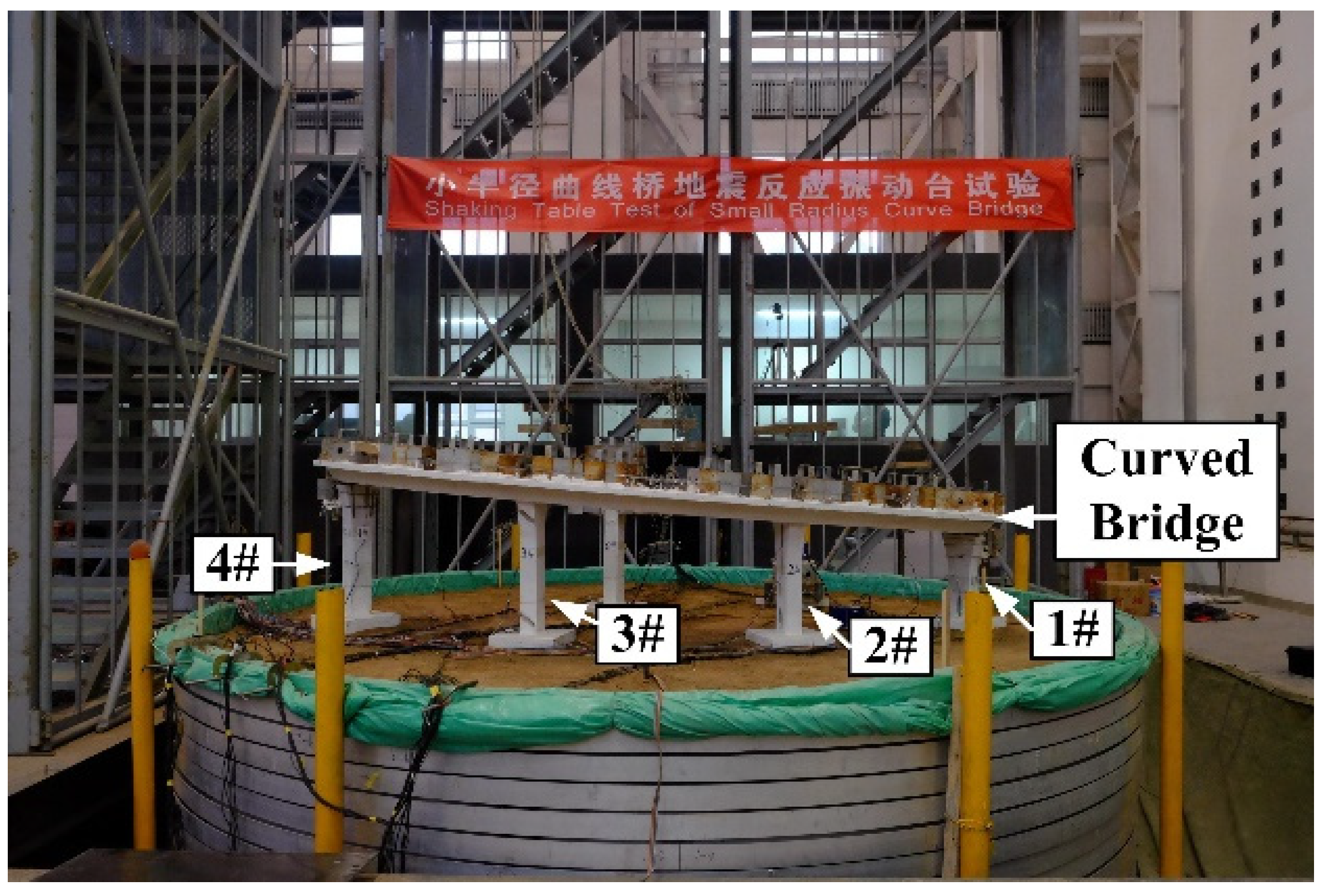

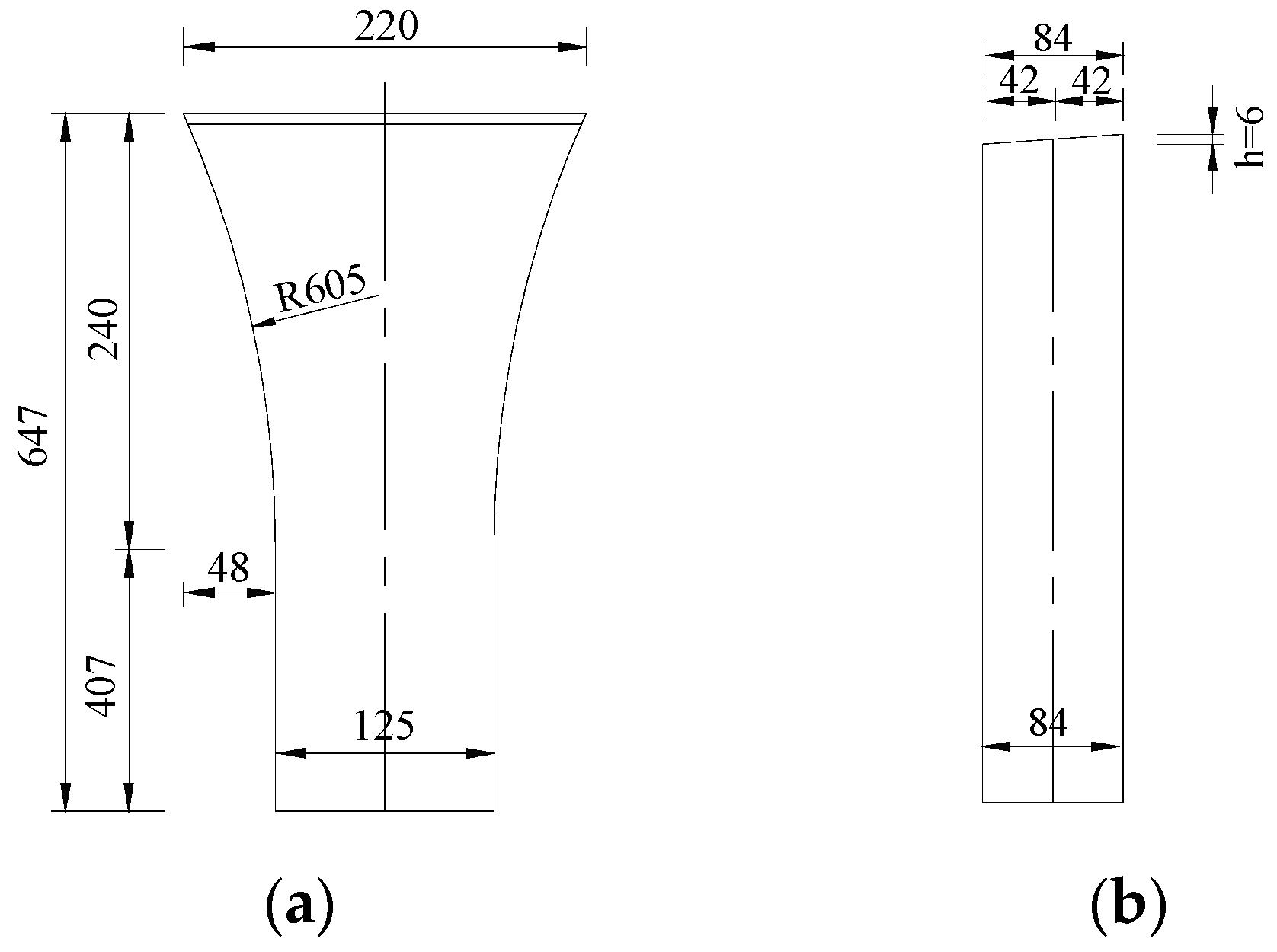
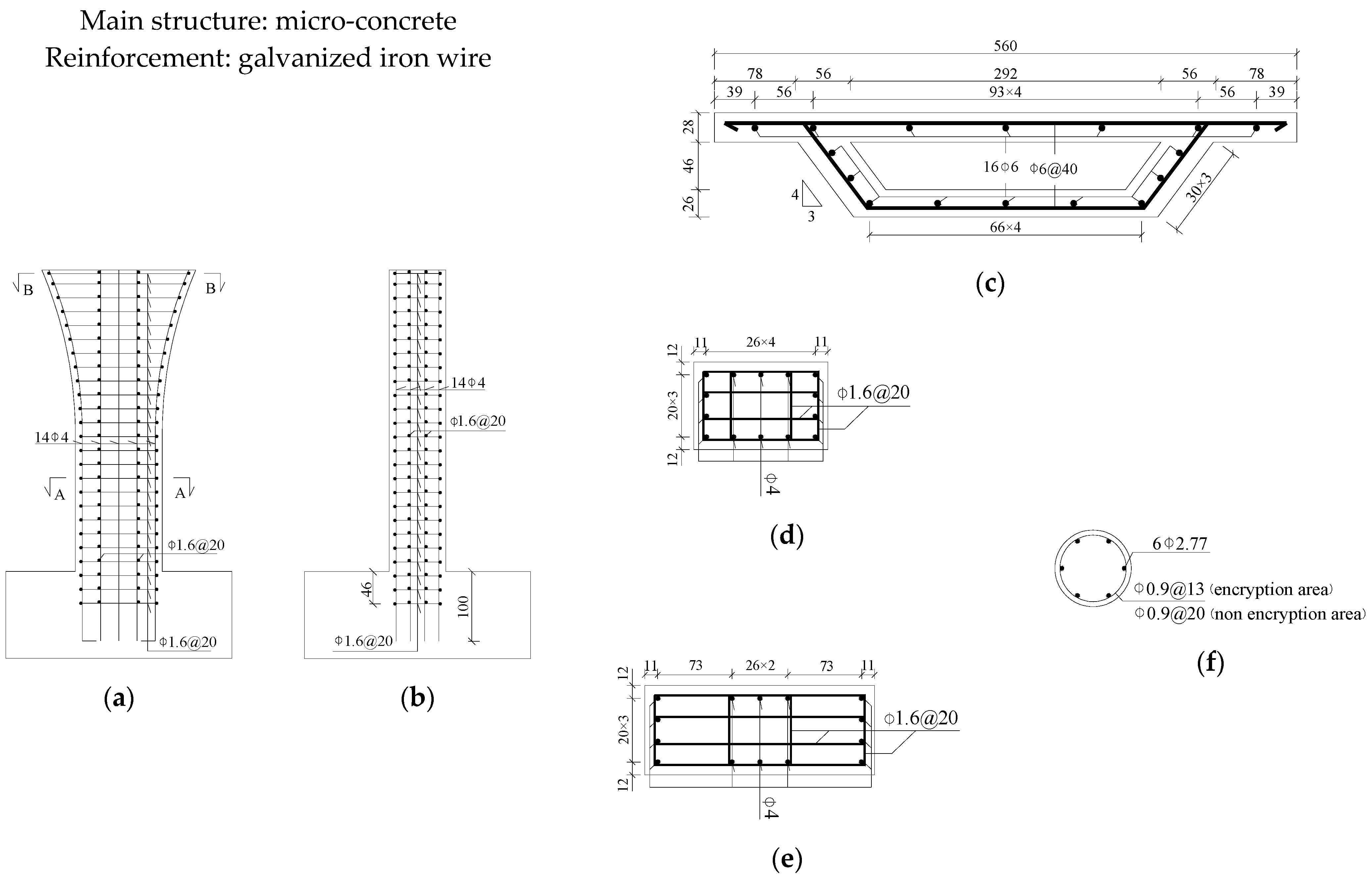


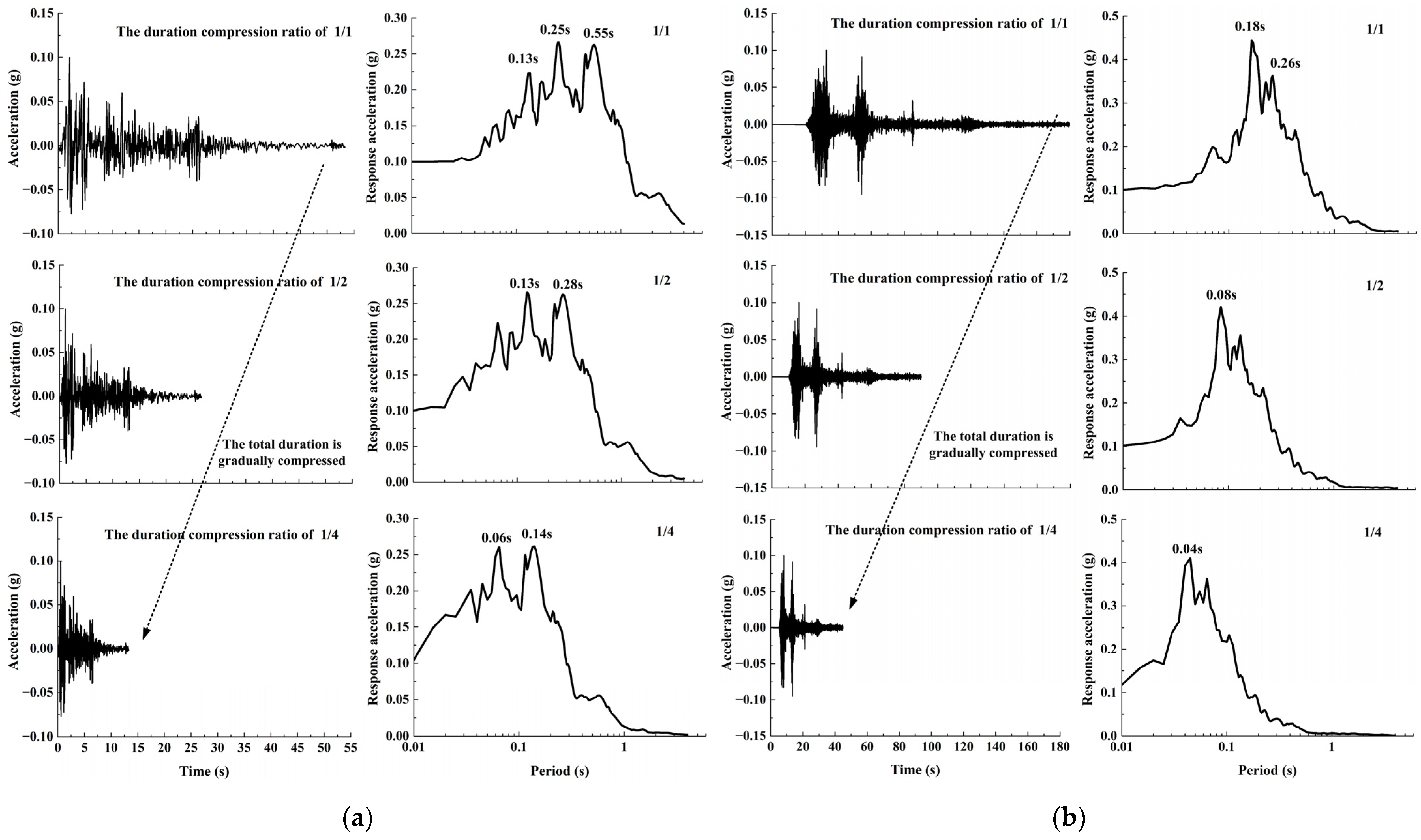
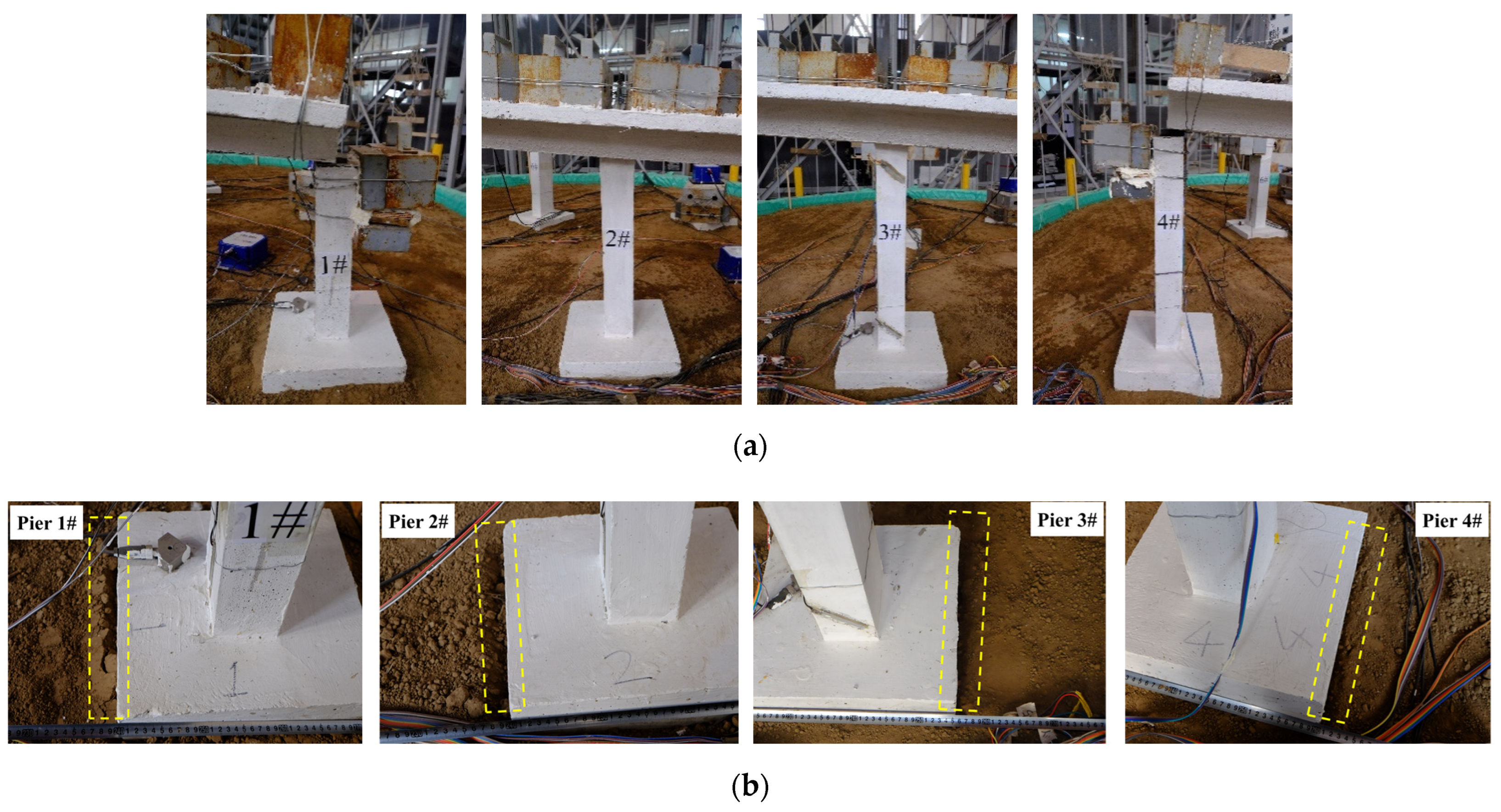
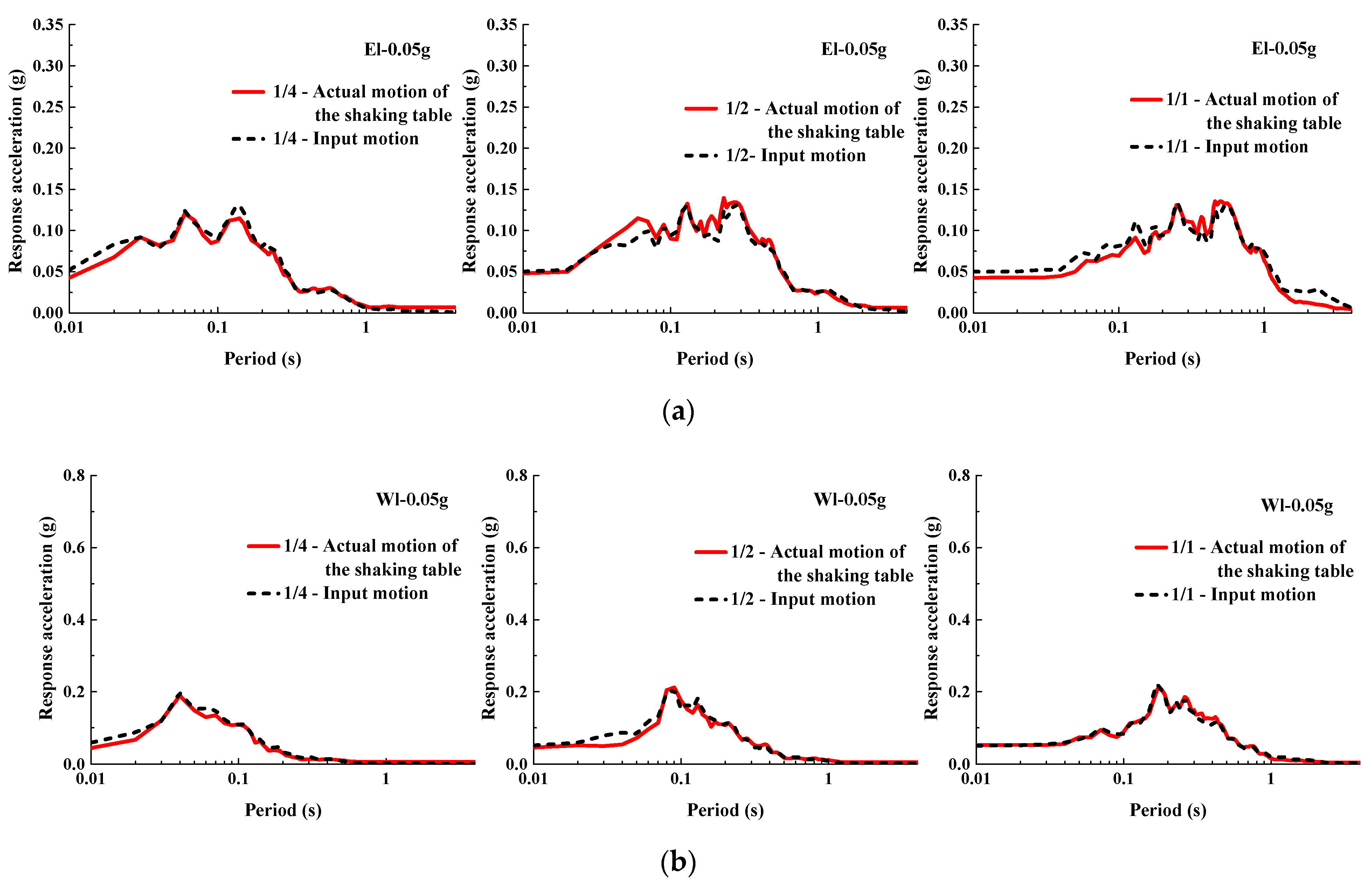

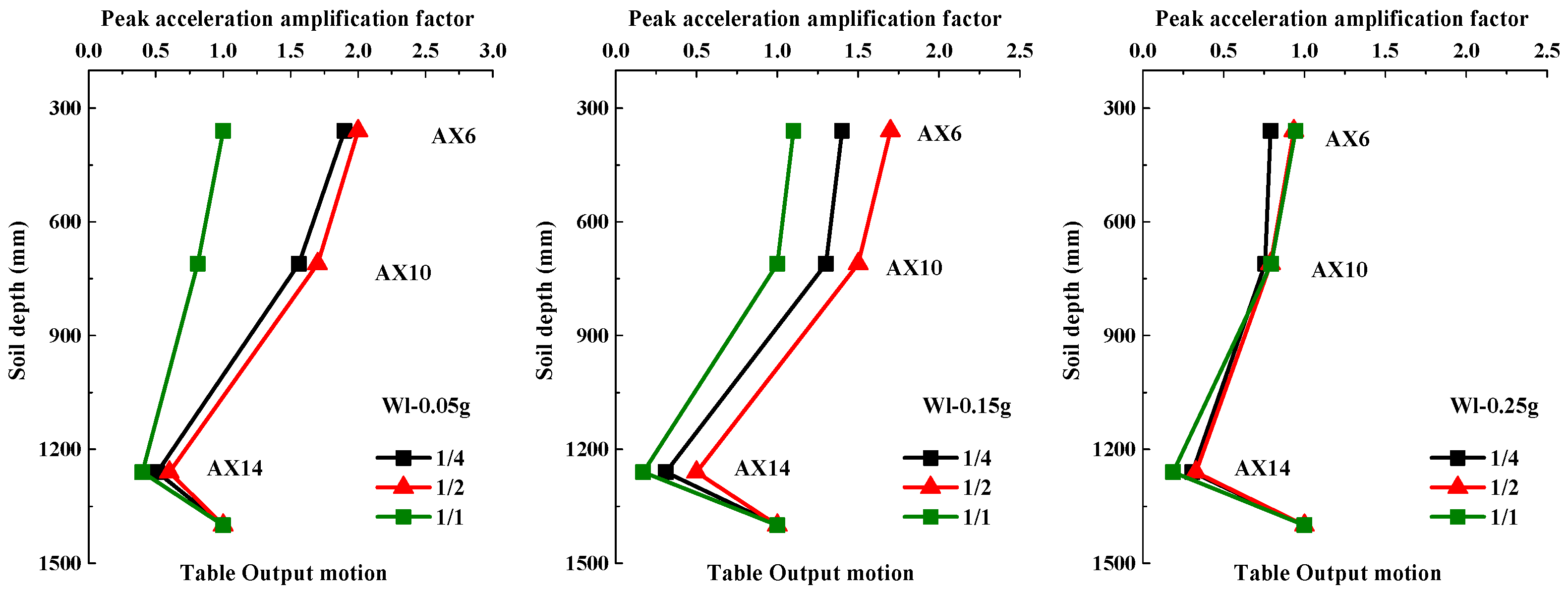




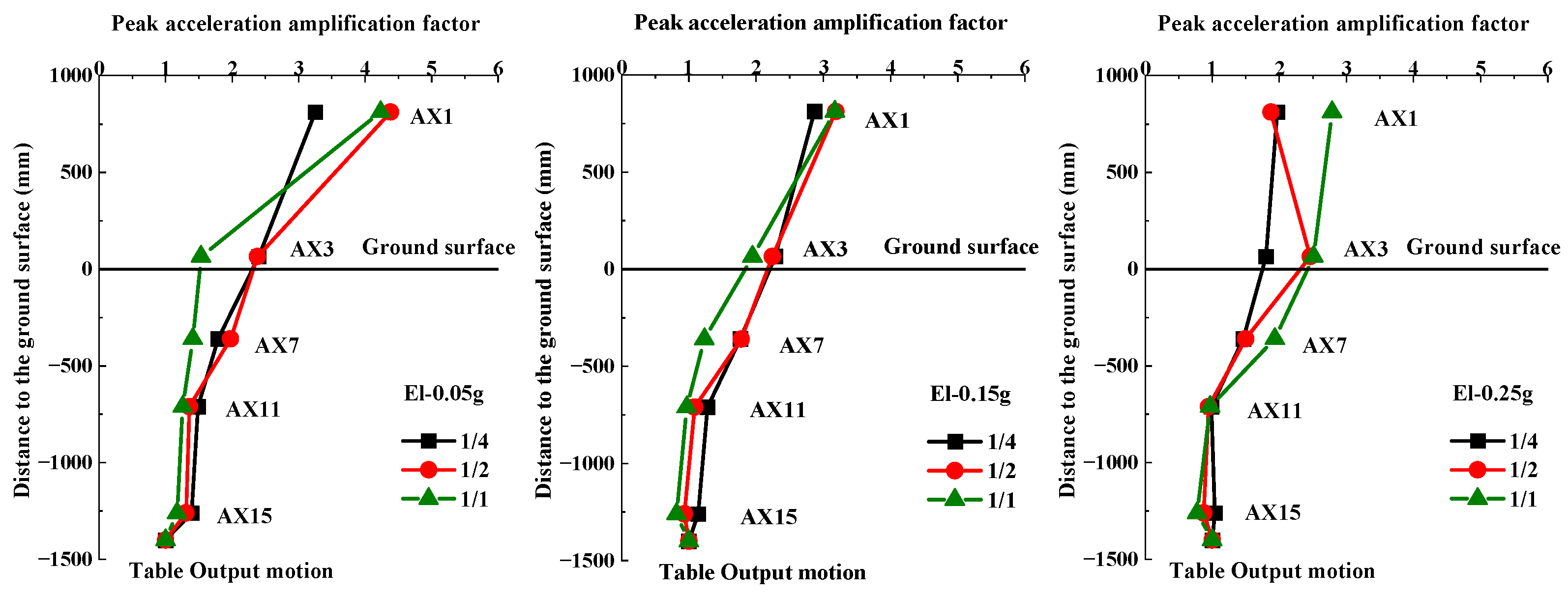
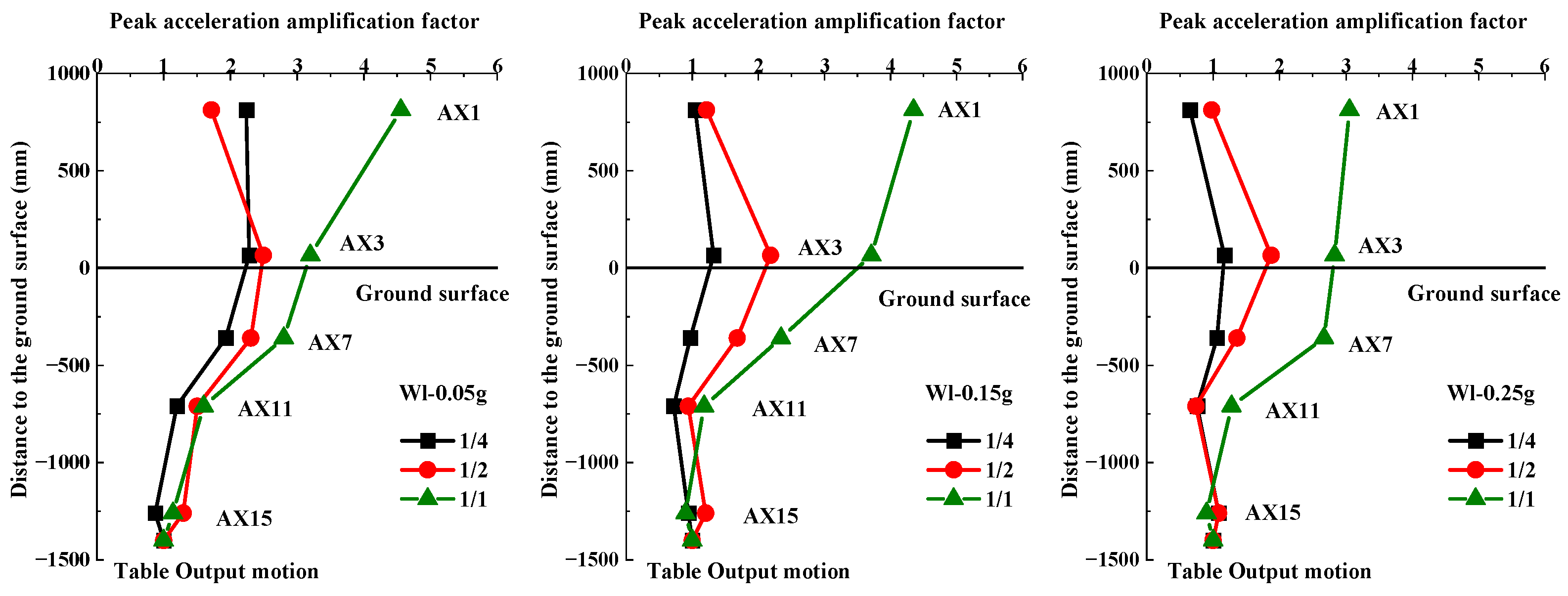


| Type | Physical Quantity | Similarity Relation | Similarity Ratio | |
|---|---|---|---|---|
| Model Structure | Model Soil | |||
| Geometry property | Length l | Sl | 1/16 | 1/4 |
| Material property | Elastic modulus E | SE | 1/4 | — |
| Equivalent Density ρ | Sρ= SE/(Sl·Sa) | 4 | 1/1 | |
| Equivalent shear-wave velocity v | Sv | — | 1/2 | |
| Dynamic property | Acceleration a | Sa | 1.0 | 1.0 |
| Time t | 1/4 | 1/2 | ||
| Frequency f | Sf = 1/St | 4.0 | 2.0 | |
| Test ID | Wave Form | Duration Compression Ratio | PGA (g) |
|---|---|---|---|
| 1 | Flat noise | 0.05 | |
| 2 | El Centro | 1/4 | 0.05 |
| 3 | Wolong | 1/4 | |
| 4 | El Centro | 1/2 | |
| 5 | Wolong | 1/2 | |
| 6 | El Centro | 1/1 | |
| 7 | Wolong | 1/1 | |
| 8 | Flat noise | 0.05 | |
| 9 | El Centro | 1/4 | 0.15 |
| 10 | Wolong | 1/4 | |
| 11 | El Centro | 1/2 | |
| 12 | Wolong | 1/2 | |
| 13 | El Centro | 1/1 | |
| 14 | Wolong | 1/1 | |
| 15 | Flat noise | 0.05 | |
| 16 | El Centro | 1/4 | 0.25 |
| 17 | Wolong | 1/4 | |
| 18 | El Centro | 1/2 | |
| 19 | Wolong | 1/2 | |
| 20 | El Centro | 1/1 | |
| 21 | Wolong | 1/1 | |
| 22 | Flat noise | 0.05 |
| Test Case | Model Soil | Model Structure | ||
|---|---|---|---|---|
| Fundamental Frequency (Hz) | Frequency Variation (%) | Fundamental Frequency (Hz) | Frequency Variation (%) | |
| 1 | 11.11 | 0 | 4.68 | 0 |
| 8 | 8.33 | 25 | 4.45 | 4.9 |
| 15 | 8.33 | 25 | 4.43 | 5.3 |
| 22 | 7.69 | 30.8 | 4.35 | 7.1 |
Publisher’s Note: MDPI stays neutral with regard to jurisdictional claims in published maps and institutional affiliations. |
© 2022 by the authors. Licensee MDPI, Basel, Switzerland. This article is an open access article distributed under the terms and conditions of the Creative Commons Attribution (CC BY) license (https://creativecommons.org/licenses/by/4.0/).
Share and Cite
Zhang, Z.; Song, C.; Li, X.; Qi, X. Influence of the Duration Compression Ratio of the Input Motion on the Seismic Response of a Soil–Pile–Bridge Structure System in Shaking Table Tests. Appl. Sci. 2022, 12, 12109. https://doi.org/10.3390/app122312109
Zhang Z, Song C, Li X, Qi X. Influence of the Duration Compression Ratio of the Input Motion on the Seismic Response of a Soil–Pile–Bridge Structure System in Shaking Table Tests. Applied Sciences. 2022; 12(23):12109. https://doi.org/10.3390/app122312109
Chicago/Turabian StyleZhang, Zhi, Chenning Song, Xiaojun Li, and Xingjun Qi. 2022. "Influence of the Duration Compression Ratio of the Input Motion on the Seismic Response of a Soil–Pile–Bridge Structure System in Shaking Table Tests" Applied Sciences 12, no. 23: 12109. https://doi.org/10.3390/app122312109





